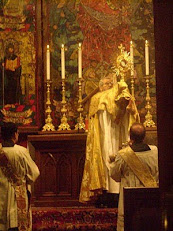Anglicans tend to know little about Anglicanism. How many are aware that the Archbishop of Canterbury's coat of arms displays the pallium? How many know what a pallium is? It is a Y shaped vestment, woven from lamb's wool, marked with crosses, worn by the archbishops of ancient, important or primatial dioceses. It hangs down back and front from the shoulders like a yoke over the chasuble. It is conferred on archbishops by the Pope and indicates the strong bond between himself and them. But the Archbishop of Canterbury is not in communion with the Bishop of Rome. Quite so. The arms of Canterbury therefore lie!Read the full article in this month's Update.
But as I say, the majority of Anglicans are ignorant of this lie. I myself am not offended. The lie is a reminder of what once was. The first Archbishop of Canterbury was sent to England by Pope Gregory the Great in 597 (when he brought with him the consecration prayer which we of the Ordinariate use at the eucharist). The lie I see as an expression of hope, or if not of hope, as an expression of what ought to be. The Archbishop of Canterbury ought to be in communion with the Bishop of Rome. The church should be one: bishops should express such unity by being in communion with all other bishops. They are, after all, supposed to be the ministers of unity. And a universal church needs a universal primate, president, presiding servant. Who can this possibly be if not the Bishop of Rome? The Eastern Orthodox recognize this and one Russian has added, "What use is primacy without jurisdiction?" What does the Archbishop of Canterbury do to foster unity? He advocates policies which drive the two churches further and further apart, the ordination of women, gay marriages, and he is evasive about the human right to life.
Then again, how many Anglicans know that off and on for some four hundred years there have been some modest attempts at Anglican Roman Catholic rapprochement? Admittedly such attempts have been more off than on. But Canon Bernard Pawley of St Paul's cathedral in London and his wife Margaret have published a history of these attempts, Canterbury and Rome Through Four Centuries...
HT to Gary Freeman.














No comments:
Post a Comment